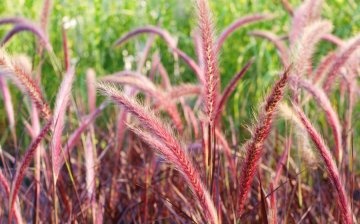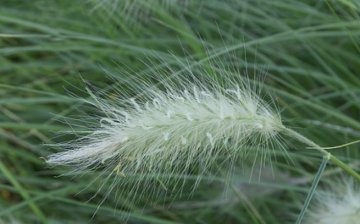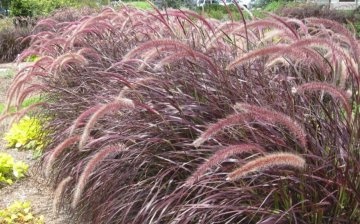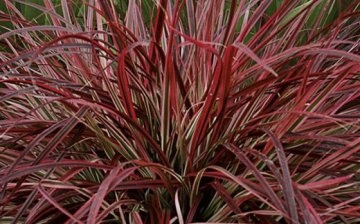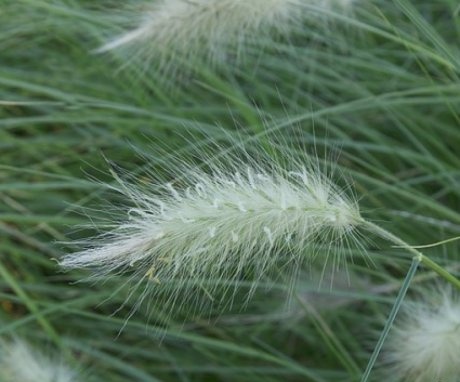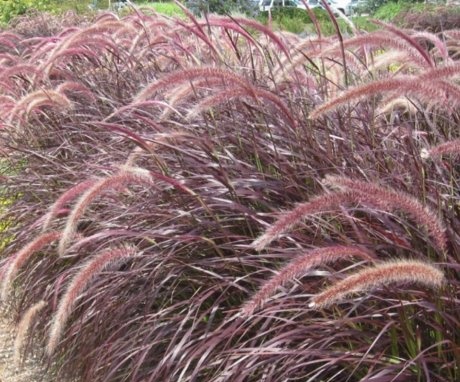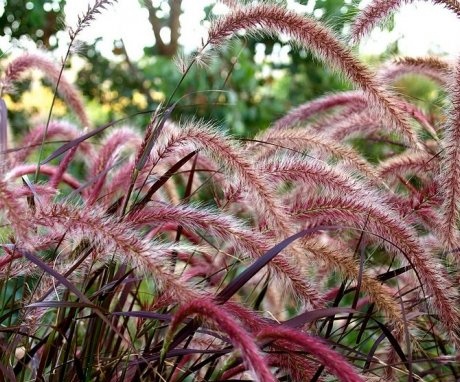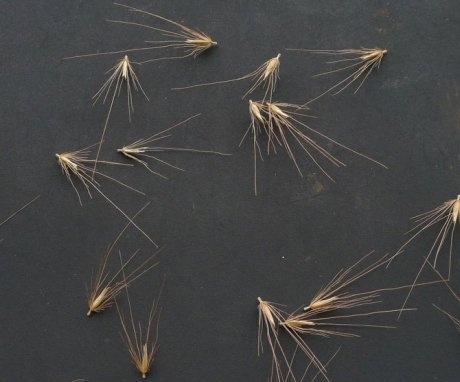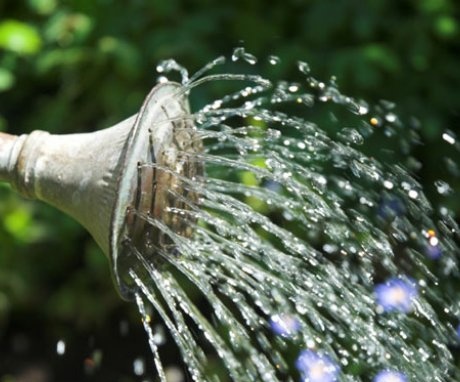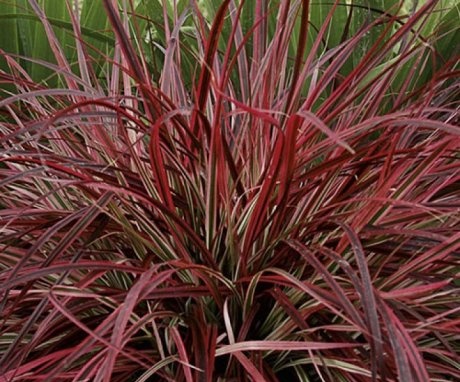How to grow bristly pennisetum on your site?
There are about 150 types of cereal plant pennisetuma... Only some of them are cultivated and grown in gardens and flower beds. In nature, most of them grow on mountain slopes in the tropics and subtropics.
Content:
- Description of the pennisetum
- Types of pinnacle
- Pennisetum bristly and its features
- Plant propagation
- Care advice
- Site use
Description of the pennisetum
Pennisetum is a perennial herb. Another name for this plant is Peristochaetum. In middle latitudes, it does not tolerate frost, so it is grown as an annual, sown every year. Its homeland is the subtropics and tropics, but some varieties are successfully grown in temperate climates. Due to its attractive appearance, it is now grown on all continents. In the southern regions it winters under cover, grows and forms beautiful turf.
The name pennisetum consists of two words for feather and bristle.
Its leaves are indeed pinnate, and the inflorescences are spikelets, collected in whorls, covered with hairy bristles. Their length depends on the type and growing conditions and can be from 3 to 30 cm.
There are no ears on the lower part of the stems. Flowers of two types are located on one spikelet. Some are bisexual, others are underdeveloped. The color of the spikelets is silvery, pink with brown, green and yellow. The base of the leaves is smooth. In autumn, the leaves of the pennisetum turn yellow, and the spikelets retain their color. This makes it even more attractive, especially against the background of evergreens.
Types of pinnacle
The main types of pennisetum:
- Foxtail, from 40 cm to 1 m in height. Blossoms with reddish panicles in August, and undersized in July. Inflorescences are milky, green, red-brown. In autumn, the leaves turn bright yellow. The bush remains beautiful until winter. Under cover it tolerates frost in the Middle Lane. Varieties: Red Head, Hameln, Compressum.
- Shaggy grows up to 60 cm. Does not tolerate winter frosts. Very decorative look. In nature, it grows on the East African mountain slopes, forming dense clumps. Used for dry winter bouquets.
- Simple originally from China. Frost-resistant species. Grows on any soil. Plant height 1.2 m. It blooms early, at the end of June. Requires a lot of light. The rhizome is very powerful, the clumps grow rapidly, drowning out neighboring plants.
- Gray is distinguished by early flowering. Its beautiful dark pink panicles bloom at the end of July. It does not tolerate frost, therefore it is grown as an annual plant. The width of the long reddish leaves is 3 cm. The fruits are called African millet and are used both for cooking and for medicinal purposes.
- Eastern in the wild can be seen on the rocky mountain slopes. Height from 15 to 80 cm. Panicles are short, from 4 to 15 cm. Color is brown-pink. Does not tolerate frost.
Pennisetum bristly and its features
Pennisetum bristly in nature also grows in the mountains, on their rocky slopes in northeastern Africa. Its stems are erect, from 70 cm to 1 m 30 cm high. The leaves are narrow, linear, about 5 mm wide, flat, of various shades of pink.Flowers - spike-shaped drooping panicles up to 30 cm long. In this case, the length of the spikelet is up to 15 cm. The color is brown-green, pink or purple.
The bush grows rapidly, its leaves form thickets. In spring and early summer, they keep upright, by autumn they droop, expanding the habitat of the plant. Therefore, it is necessary to plant other plants next to it, for example, roses, taking into account this fact.
The popular variety Rubrum Fireworks has bright red leaves and purple inflorescences up to 35 cm long. Spikelets are collected in 2-3 pieces, long, up to 4 cm, feathery bristles are placed below. The variety is low, up to 70 cm. Leaves are 2 to 6 mm wide. In autumn, its ears are cut to create dry bouquets.
The bristly pennisetum bush is sometimes called fountain grass.
This is due to the fact that his panicles, directed from the center of the bush, create a kind of fountain. They look especially impressive in windy weather. Panicles flutter in different directions under his gusts. The disadvantages of pennisetum gardeners consider the sharp edges of the leaves, which are easy to cut, the spontaneous dispersion of seeds and the fact that the bush must be heavily cut in the spring. But these shortcomings are covered by the beauty and uniqueness of the plant, which retains its beautiful appearance from spring to late autumn, and in the southern regions also in winter.
Plant propagation
All Pennisetum varieties breed seeds... They are sown in open ground in early May. Flower panicles will appear next year. In order for the plant to bloom in the first year, the seeds are sown for seedlings in February. You can do this in April, but then it will bloom next year. In this case, they are transplanted into the ground in a month. The advantage of this planting method is that the percentage of germination and survival of plants will be higher.
It is better to sow in separate pots or cups, because cereals do not tolerate transplanting well.
The seeds are not sprinkled with earth, but only slightly pressed inward. Germinate at a temperature of 18 ° C in a week. Then they need to be illuminated with phytolamps. In May, when young plants reach a height of 12 cm, they are transplanted to a permanent place. Perennials, wintering under cover, propagate in spring dividing the bush... The operation is performed no more than once every five years. The bush should have time to get stronger between transplants. Each of the divisions should not be very small. In this case, the bristly pennisetum will bloom in the year of transplantation.
What should be the conditions for the plant:
- Pennisetum bristly prefers to grow in well-lit areas, protected from drafts. If there is no mountainous area, it is grown on the plains.
- The soil must be fertile. Grows poorly on sandstones. Such soil is too dry, and the plant requires a sufficient amount of moisture for normal development.
- At the same time, bristly pennisetum does not tolerate stagnation of water in root system... Therefore, when planting or sowing it in wet areas or where groundwater is too close to the surface, they first arrange drainage for it. It can be river sand or gravel, which is common for a plant in natural conditions. A layer of fertile soil rich in humus is poured on top. For this, humus is introduced or compost.
Sometimes bristle pennisetum is grown in containers. They are installed near the walls of houses or other buildings. For the winter, the upper part is not cut off, the container is transferred to a room with a temperature of at least 15 degrees. Almost no watering. Remove dried leaves. Can be used as a houseplant.
Care advice
The plant after transplanting needs regular watering. Use water heated in the sun. In the future, when the plant gets stronger and begins to develop, it is watered when the soil dries up.
Weeds are regularly removed near young plants and the soil is loosened. When they grow up, the weeds will not be afraid of them.
Plants located on nutrient soils do not need to be fertilized.
But making a complete complex mineral fertilizer will improve the condition and appearance of the cirrus. It is brought in once a month. There are no insects on our territory that would harm the bristly pennisetum. Known diseases do not affect him either. With too much watering and poor drainage, leaf discoloration may occur. If the amount of moisture is not reduced, the plant may die.
In autumn, the long leaves of the pennisetum are not cut off. Leave them for the winter so that they create protection from frost. But the leaves themselves will not be enough. You need to create additional protection. To do this, use a non-woven covering material that allows air to pass through, covered with spruce branches.
Site use
The perishache is planted in separate groups, of which they form hedges... They look good in tapeworms. They are grown in containers that can be moved from one place to another.
Tall bushes of bristly pennisetum are often planted in the background so that they do not obscure the short, large-flowered and beautifully flowering plants.
They are also planted on alpine hills, placing them in the center of the composition. The bristly pennisetum naturally looks near artificial reservoirs, in patios, on terraces or lawns. It is irreplaceable for creating a cereal garden.
Pennisetum bristly Rubrum Fireworks is often planted behind low carpets of flowering ornamental plants. Good neighbors are roses with yellow flowers, veronica, yarrow, catnip... Cutting panicles for dry bouquets are harvested in August, when the seeds are not yet ripe, but the spikelets already have a beautiful appearance.
More information can be found in the video:



